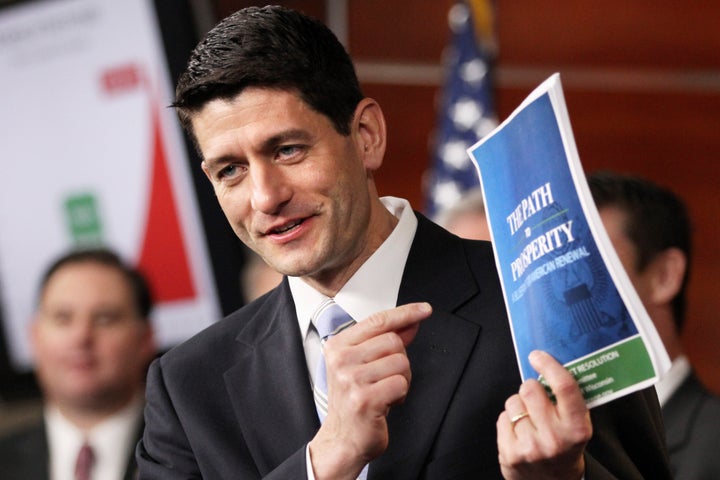
Congressional Republicans' budget guru said Tuesday that he wants Congress to overhaul food stamps and other safety net programs in the way welfare was reformed 16 years ago -- even though recent data suggest welfare reform's achievements were fleeting.
"The 1996 welfare reform was very successful in getting toward an upward-mobile society, in getting people off of dependency and on to lives of self-sufficiency," Rep. Paul Ryan (R-Wis.) said Tuesday.
"We propose welfare reform round 2," Ryan said, apparently referring to the Welfare Reform Act proposed last year by the conservative Republican Study Committee.
"Let's take those principles of welfare reform that were extremely successful in getting people out of lives of dependency and back on their feet," Ryan said. His plan would turn the funding for federal programs like food stamps and housing assistance into block grants -- a fixed yearly allotment granting states greater spending flexibility. States would then set work requirements and time limits for the benefits.
"This is a path that we believe reignites and renews the American idea," Ryan said. "It reclaims the opportunity society with a safety net, which we do believe must exist for people who cannot help themselves, for people who are down on their luck, so they can get back on their feet."
"But we don't want to turn the safety net into a hammock that lulls able-bodied people to lives of dependency and complacency, that drains them of their will and their incentive to make the most of their lives," Ryan added.
Ryan's office did not respond to multiple requests for evidence to support his claim that welfare reform has been such a success. Several recent studies suggest the opposite is true.
The Personal Responsibility and Work Opportunity Act of 1996 transformed welfare -- then known as the Aid to Families with Dependent Children program -- into the Temporary Assistance for Needy Families program, or TANF. It ended the program as an entitlement, required single mothers to engage in work activities in order to receive cash benefits and limited the duration of benefits.
"The Temporary Assistance for Needy Families reforms cut welfare caseloads in half as poverty rates declined," Ryan's blueprint says. "In stark contrast to critics' fears, child-poverty rates fell 1 percent per year in the five years following the passage of TANF in 1996."
But since then, the child poverty rate has gone back up, even as welfare caseloads have continued to decline. The poverty rate for Americans under 18 was 20.5 percent in 1996. Now it's 22 percent.
"The success of welfare reform is way oversold because it's based on early years when the economy was booming," following the enactment of the reform law, said LaDonna Pavetti of the Center on Budget and Policy Priorities in an interview.
According to an analysis by Pavetti and her colleague Danilo Trisi, in 1996, 68 out of every 100 poor families with children received welfare cash assistance. Now the ratio is 27 out of 100. Trisi and Pavetti specifically blame the program's block-grant structure for giving states flexibility to use funds for things other than helping poor people.
The TANF program also failed to meet rising economic need during the Great Recession that started in 2007, according to a 2011 report by the Urban Institute. While the national unemployment rate jumped 88 percent from 2007 to 2010, welfare caseloads rose just 14 percent. Prior to welfare reform, that program tracked the unemployment rate more closely.
A February review by the National Poverty Center of poverty data since 1996 estimates that the number of households in extreme poverty -- composed of people living on $2 or less per capita daily, according to the World Bank's definition -- rose from 636,000 in 1996 to 1.46 million in 2011 -- an increase of 130 percent.
"The prevalence of extreme poverty rose sharply between 1996 and 2011," the report stated. "This growth has been concentrated among those groups that were most affected by the 1996 welfare reform."
The report estimated that if food stamp aid is considered, the count of those living in extreme poverty is lower -- just 475,000 in the mid-'90s, rising to 800,000 last year.
Yet lowering spending on food stamps is a top target of Ryan's plan, which notes their cost has increased from $18 billion in 2001 to $80 billion today. In that time period, enrollment of aid recipients has grown from 17.3 million to 46.6 million.
"This last recession would have been quite horrific, and there would have been quite a great deal of suffering and hunger, if food stamps were as unresponsive as TANF was," said Elizabeth Lower-Basch, a senior analyst with the D.C.-based Center on Law and Social Policy.